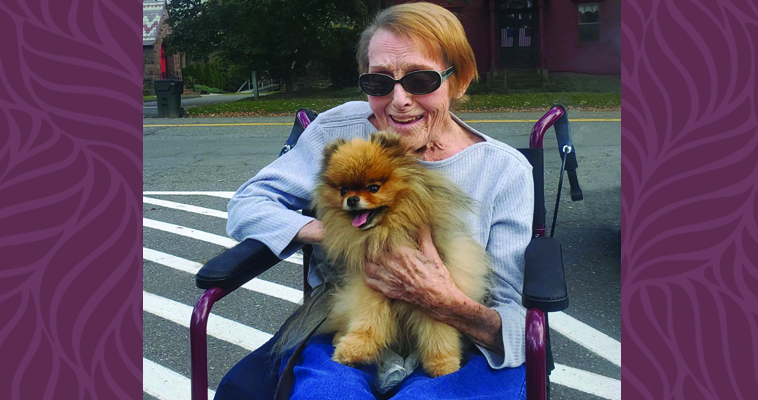
Prior to living in a nursing facility, Virginia described her life as “normal”. In her mid-90s, she was independent and living in her own home. She enjoyed designing and decorating her home, cooking for herself, making her own plans, and being able to live life on her own terms.
On a cold day in January 2020, Virginia bumped her knee on the side of the bathtub. Although it was painful, she continued through the rest of her day and didn’t think much of it. The next morning, she knew something was terribly wrong when she could not move her knee or walk on it. With few options, she went to the ER.
While in the ER, doctors drained excess fluid from Virginia’s knee and thought her sudden pain was due to gout. Although the doctors wanted to do tests on the fluid that was drained, they sent her home with a prescription from some pain meds. “I wish the story ended there,” she explained. Instead, Virginia had a bad reaction to her pain medicine that caused hallucinations and other symptoms that forced her back to the emergency room. By that time, results from the fluid in her knee showed it was not gout causing her knee pain, but instead a severe bacterial infection.
She required surgery to clear the infection from her knee. She spent about a week in the hospital recovering before transitioning to a skilled nursing facility for rehab. After having been there only a month, the COVID pandemic hit and the world began to shut down. Many people remember being stuck at home during this time; Virginia remembers being stuck in a facility.
As if her new surroundings were not hard enough to adjust to, COVID made living there a nightmare. She recalls being stuck in her room all day, forced to listen to her roommate’s TV while she tried to read. She remembers the kitchen shutting down, and the already undesirable food being served on styrofoam plates and trays, ice cold by the time it reached her. She remembers her daughter, Lestyn, driving from Vermont just to sit outside her window, the only way they could see each other. She remembers talking to Lestyn on the phone each day, explaining how desperate she was to get out. Due to COVID restrictions during this time, Virginia spent every day in her bed with no options for activities or therapies. It was detrimental to her physical abilities, including her ability to walk.
The facility social worker eventually introduced Lestyn to the Money Follows the Person (MFP) program. They submitted an application and started Virginia’s journey home. The social worker, Lestyn, and a care manager from MFP began working together to complete the necessary steps while overcoming the challenges of COVID restrictions. Virginia remembers these months as especially challenging because she could not be as involved in the planning process as she could have been pre-COVID. She had to rely on and trust her daughter to take care of it all.
Finally, in December 2020 after almost a year of waiting, Virginia was ready to transition back to her home. Through MFP, Virginia hired a live-in personal care assistant who makes sure all her needs are met. She also receives physical and occupational therapy in her own home to help regain strength and skills that she lost while living in the facility. Lestyn recalls how much she appreciated the follow up and check ins from the MFP team.
When reflecting on her first days back home, she said it was “as if I had gone to heaven”. Virginia has been back home for a year and a half, and is once again enjoying her free time reading and picking out new paint colors for her home. “I love being surrounded by my own things and feeling comfortable. I never once felt at home in the nursing home. Living at home is the ultimate for me.”
Virginia was thrilled to share that she will meet her newest great granddaughter in a few months, a moment that will be much more meaningful from the comfort of her home.
Read the CT Money Follows the Person Quarterly Report
MFP Demonstration Background
The Money Follows the Person Rebalancing Demonstration, created by Section 6071 of the Deficit Reduction Act of 2005, supports States’ efforts to “rebalance” their long-term support systems, so that individuals can choose where to live and receive services. One of the major objectives of Money Follows the Person (MFP) is “to increase the use of home and community based, rather than institutional, long-term care services.” MFP supports this by offering grantee States an enhanced Federal Medical Assistance Percentage on qualified services. MFP also offers states the flexibility to provide supplemental services, such as assistive technology and enhanced transition services, to assist in successful transitions. States are then expected to reinvest the savings over the cost of institutional services to rebalance their long-term services and supports for older adults and people with disabilities to a community-based orientation.
